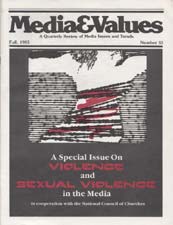ADVOCACY: Violence Against Women Tests Limits of the Law
|
This article originally appeared in Issue# 33
|
The perennial battle against degrading images of women in the media has recently seized upon a new weapon: the power of the state. With great fanfare, the Reagan administration has established a commission that will bold hearings to look for ways to 'control' pornography. And in several cities, anti-pornography laws have been drafted although, so far, only Indianapolis, Indiana has adopted one. It seems to me that this law and order approach is simply a sign of people's growing impatience with other responses to this increasing social issue. There are serious problems, however, with proposals to hand over the solution to the state.
The Indianapolis ordinance attempts to avoid the First Amendment bar to prohibitions against all forms of speech (except obscenity) by making pornography a civil rights violation. The ordinance provides the basis for private citizens to sue the producers, marketers and distributors of materials because their "graphic, sexually explicit subordination of women whether in pictures or words" inflicts injury upon all women, as a class, in society. As a legal technique, this law first appears quite ingenious. Unfortunately, the fascination is more with the craft than the cure. Why? Let's look at some implications of the ordinance-as-solution.
- " It suggests pornography is a limited substance. But images of violence against women are not found just in aggressive pornography or sexually explicit rock videos. It lets advertising and other run-of-the-mill denigrating images off the hook.
- " It depends on local officials to stamp it out. Unfortunately, the law has historically supported the treatment of women as the property of men. Despite recent progress in sensitizing police departments and courts to women's rights as independent persons, we would be naïve to think that this serious attitudinal problem has been conquered.
- " It pretends that there is agreement on what material is actually harmful. Not true. One person's sexuality may be another's pornography. Definition here is very difficult.
- " To be adopted, such ordinances require coalitions of questionable value for women. In Indianapolis, it required the combined support of feminist and right-wing groups. Who is furthering whose interests? Are such efforts providing a distraction from other pressing issues such as child care and pay equity?
The Indianapolis ordinance was challenged in court and overturned. But interestingly, the court accepted the city's argument that pornography causes injury. Yet there was still no legal basis to make it a prosecutable offense. The court explained that there can be no law against one form of speech without jeopardizing all forms of speech. Including, of course, religious and political beliefs. The main point here is that the law cannot provide a remedy to the subordination of women. In my opinion, what is needed are major educational efforts along with community organizing strategies to help people of all ages challenge denigrating media images of women and men. While painstaking, such efforts will do more to "sensitize" our fellow human beings than laws that curb essential freedoms.



